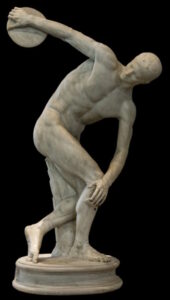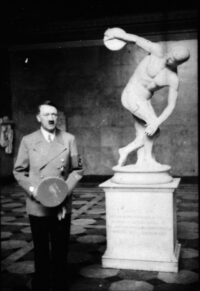German museum weirdly asks Italy to give back the Discobolus
The Discobolus Palombara, also known as the Discus Thrower, was discovered in 1781 at the Villa Palombara on the Esquiline Hill, one of the palaces of the princely Massimo family. It was a 1st-century A.D. marble copy of a famous 5th century B.C. bronze by the Athenian sculptor Myron of Eleutherae. The original was probably cast for the city of Sparta. The pose of the athlete captured at the moment of maximum coiled tension just before he spins around and releases the discus was introduced a new dynamism into Classical sculpture that was widely admired and copied for centuries.
The coins are named for the cavalier’s cross that is always found on the reverse of these denari. Both the obverse and reverse have what looks like lettering bordering the central images and symbols, but they are imitations, a pseudo-legend rather than an inscription. Without any real inscriptions or any other references to the minting year, they are impossible to date precisely, but they were only in production between 965 A.D. and the beginning of the 12th century. They have unusually high edges on both sides.
Cross denari were the primary currency in what is now Poland in the second half of the 11th century. Several hoards of cross denari hve been found in Poland, the largest of which, discovered in 1935 in Słuszków, central Poland, contained more than 12,500 coins.
According to Łukasz Szczepański from the Ostróda Museum, the location of this treasure fits in an interesting way with the identified settlement structure of the southern Jeziorak microregion.
“We have there, among others, a Prussian stronghold from the 11th-12th centuries, a network of open settlements, various types of earth fortifications that are attributed to Prussia. This treasure complements our knowledge about the settlement activity of this zone” – said the archaeologist.

That harmony was in stark contrast to the “degenerate” aesthetics of modernist art.
German museum
The prologue to Leni Riefenstahl’s 1938 Olympia, her influential, albeit interminable, movie dedicated to the 1936 Olympics, draws the connection between the classical ideal of beauty and the New German Man explicitly. A long montage of the ruins of the Acropolis dissolving into famous Greco-Roman statues, prominently featuring ones in German collections
Riefenstahl returns to the faun several times. The second is an extreme closeup of the Medusa Rondanini, also collected by Ludwig on his Grand Tour and in the Glyptothek. The Glyptothek’s Braschi Aphrodite makes an appearance as well.
German museum

German museum The dispute arose when the director of the National Roman Museum requested the statue’s 17th Century marble base be returned from the Antikensammlungen state antiquities collection. The German museum instead asked for the return of the Discobolus Palombara, saying it had been illegally transported to Italy in 1948, the Corriere della Sera newspaper reported Friday.
German maseum Italy’s culture minister, Gennaro Sangiuliano, expressed doubts that the German culture minister, Claudia Roth, was aware of the Bavarian request.
“Over my dead body. The work absolutely must remain in Italy because it is a national treasure,’’ Sangiuliano was quoted by Corriere as saying, adding that he hoped that the base would be returned.


